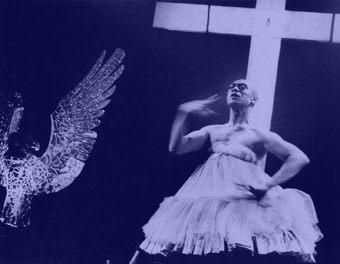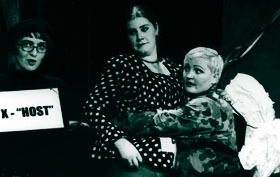Sydney & Wollongong: atoms and fuel
Keith Gallasch: new performance

Brian Fuata, Museum of Fetishized Identities
photo Heidrun Löhr
Brian Fuata, Museum of Fetishized Identities
I was raised on a steady diet of Chekhovs performed in the manner and dialect of langorous English tea parties. It was a relief then to encounter the Benedict Andrews-Beatrix Christian version towards the end of its Sydney Theatre Company season (Drama Theatre, Sydney Opera House, opened May 11), angular, impassioned, unpredictable—a good test of a production for a play we know only too well. It remains curiously faithful for all its lateral moves, disk-spinning, occasional (if sometimes just too out of whack) contemporary references and magically eccentric, full-bodied and frightening performances—not without the requisite moments of reflection and interiority the playwright demands. “Hyper-real” is how the collaborators describe the characters, and I think they’re right. It’s the astonishing range of emotion and its moments of sharp visible embodiment that fuelled me. This contemporary playing doesn’t feed everyone in the audience. The familiar made strange got a bit too much for some: Irina’s insistent “To Moscow, to Moscow, to Moscow…” at the end of Act II was quietly met with “To Mosman, to Mosman…” by one disgruntled patron. But the performance manner is now, it is the future. But whose? Why is Masha singing Joni Mitchell’s paean to Woodstock—she can’t get it out of her head. It’s awkward, it jars, but it says that the dreams of 1968 have failed utterly. Act III looks uncomfortably like Bosnia. I’d just read Michel Houellebecq’s manic-depressive novel Atomised, so I was edgy about any more baby-boomer bashing (we get enough of that in the Sydney Morning Herald) and the denunciation of 400 years of less than humane humanism. So I went home in a spin, fuelled by the playing, emptied by an Andrews-Christian vision grimmer than any Chekhov I’d supped with before.
Guillermo Gomez Pena’s The Museum of Fetisihised Identities (Performance Space, July 5-14) was one of the most remarkable experiences of recent years, pulling my disparate atoms into fractal coherence across the 3 hour performance. The San Francisco-based Mexican artist and his cohort Yuan Ybarra collaborated with Australian artists for 5 weeks to create a set of living, recycled, sometimes mutating tableaux that transform an increasing number of the audience across the season into performers. As RealTime’s Kirsten Krauth put it: “It’s hard to maintain a passion for theatre-with-boundaries after experiencing The Museum of Fetishised Identities. A venue done up like a rave with performances fluid and revolving and great thumping music, where you can rove with a drink in one hand and a machine gun in the other is pretty hard to beat”. This tightly choreographed production moves from museum (a collection of bizarre cultural types, partly constructed from the performers’ lives) to ritual, culminating in the crucifixion of Ybarra with ‘Chicano’ scrawled across his chest (how does, Gomez Pena repeatedly asks, a Mexican become a Chicano).
Despite the cross, the skeleton that hangs above, the density of colour and sound and the specificity of Gomez’s own images (punch drunk Third World boxer, beggar dwarf, sculptor of terror tableaux using the audience) the whole feels less Mexican than aberrantly and creatively global ie not corporate. The Australian collaborators produce images that evoke constellated local subcultures (feminist lesbian warrior dj), public transgressions (a naked woman climbs into a perspex display box and smears it with breast milk), cultural caricature (someone in a kangaroo mask in a flailing dance with a cricket bat), foreign experience (the ritual of an Indian street beggar turned into an appalling fashion parade using the audience). Valerie Berry, Barbara Clare, Brian Fuata, Victoria Spence, Caitlin Newton-Broad, Rolando Ramos, Claudia Chidiac and Agatha Gothe-Snape perform with commitment and precision, some revealing surprising, new dimensions when deprived of their usual means of expression. Digital artist Jorge Cantellano (satirical, animated images of branded synthetic humans) and video installation artist Vahid Vahed (dark imagery of political torment across the last century) complete the picture—an exhilarating expression of difference in the age of globalism that sometimes stops you in your tracks. A bit like partying your way through the Apocalypse.
Urban Theatre Project’s Asylum (director Claudia Chidiac; May 31-June 9), in a disused shop in a western Sydney suburb was not at all celebratory. Its more familiar assemblage of monologue tales of the refugee encased in a fragile narrative nonetheless had power and poignancy because of the great strength of some mature performers and the immediacy of the political situation in Australia’s atrocious handling of refugees. We entered the performance area as refugees, hassled by officials we couldn’t understand and we watched the performance through wire as projected images (Denis Beaubois) and unfamiliar sound worlds (Rik Rue) disoriented us, as we tried, pertinently, to read the writing on the walls that these inmates patiently worked at. In the end a refugee is forced to go home, presumably to death. As heavy as the hand is that hits you with this, the truth is as horribly light as Kundera’s: it’s hard to walk from the space, to drive home in one piece.
Critical Mass Theatre’s HAZCHEM (May 18-June 17) is bewildering and mysteriously affecting. A pre-show guided tour through the Wollongong City Gallery doesn’t prepare you for the council chamber balcony view through a mist of a yellow car atop a mound of sea-rounded rocks, a body flung across the car roof. It’s an image of beauty and of horror, the end of a story we’ll never know. What we witness seems to be some kind of aftermath in which perhaps a family is pulled apart, atomised. But HAZCHEM refuses such guessing and goes the way of reverie as headlines of crime and corruption and crashes and vast oceans wave across the chamber walls. A work siren sounds, grabbing everyone’s attention. So does rock’n’roll and the footy. There’s a brief sentimental evocation of a 60s holiday in the car, a trip to the Kiama blowhole. We’re sliding back. Trite memories and short-lived suspicions about pollution jostle, a comic but touching courtship is expressed in local terms (“you’re my smelter’), a slow death is mused over, and a running panic grabs thesel individuals (pulling them out of their cages, off their bikes, out of their preoccupations), until they unite atop the mayoral bench, yelling, punching the air, powerless. There’s been a car crash, a city has crashed, something has been lost. Deborah Leiser’s precise, visually intense direction yields focussed performances from a mostly experienced cast (Janys Hays, Bruce Keller, Jeff Stein, Bel Macedone, Ian McGregor) who know how to stretch time and contract space as well as how to act as the work switches between the imagistic demands of contemporary performance and fragmentary sketches of the everyday. I missed the significance of many of the local references and I wasn’t certain how HAZCHEM added up, so I wasn’t always at one with it and its sometimes cut and paste structure, but it’s a striking and worrying work. I hope Critical Mass Theatre (made up of artists with an association with the city) and its gallery partner persist in building contemporary performance in Wollongong.

Bel Brown, Marianne Hender, Claire Burrow, 100 Confessions
photo Heidrun Löhr
Bel Brown, Marianne Hender, Claire Burrow, 100 Confessions
David Williams’ 100 Confessions in PACT Youth Theatre’s Forked Tongues (PACT Theatre, May 16-27) featuring 3 emerging directors (Williams, Cindy Rodriguez, Briony Dunn), is a chaotic party cum game cum social experiment that requires improvisational skills and timing that are mostly beyond its players. Even so, recurrent gags, playing with labels, dodgy confessions, shifting allegiances, outrageous scenarios, some strong indiosyncratic performances and seriously escalating tension yield a surprising level of coherence. Rodriguez’ Picasso’s Blood is the most assured work on the bill. As with Melbourne writer-director Jenny Kemp’s play with gesture, group movement, iconic text and obsessive behaviour, Rodriguez creates a dream world where characters split and multiply and the relationship between a Bluebeard Picasso and Dora Maar goes to pieces. Knife play, a blood obsession, a pair of limping marionette legs, and sound waves of ocean, soprano and vocalise female chorus recur with nightmarish intensity, evoking a labyrinth of love.
Verity Laughton’s Burning (Griffin Theatre Company, June 15-July 14) unfolds like a staged novel, explaining its way forward, labouring its cluster of secrets and the predictable revelations of a well-worn theatrical model. For a ghost story it lacks the dynamic of stillness and alarm that yield eeriness and fright and a hoped for epiphany. Laughton is at her best when poetic. In Burning the dialogue is for the most part too earthed, the scenario uncomfortably middlebrow, the naturalistic to-ing and fro-ing too busy. Yet the writer is onto something that white Australians need to engage with, their relationship with the land (even if it is someone else’s) built up over 200 years. Cloudstreet awkwardly explores some of this terrain (though not with Burning’s explicit Celtic focus) and Miriam Dixson (The Imaginary Australian, UNSW Press,1999) and Jennifer Rutherford (The Gauche Intruder, Melbourne University Press, 2000), among others, provide rich insights. I wanted Burning to work some magic on me, to answer, however poetically, however intuitively, a big question, but I couldn’t see past its mechanics (some of which, like the ramped, enclosing wall of photocopies were in fact magical). I left as I had come, incomplete. Atomised.
Kate Champion’s About Face (The Studio, Sydney Opera House, June 5 -16, see Erin Brannigan’s review) may have suffered from an overly episodic structure and a bits’n’pieces soundtrack, but its account of a personality attempting to reintegrate itself was powerfully conveyed by the interplay of the performer live before us and on 2 screens. A horizontal screen above revealed a slow motion, suicidal fall; a large vertical screen behind a door yielded an encounter with multiplying selves. On the screen above a survelliance camera caught Champion at the door of her apartment—trying to gain access to herself. Brigid Kitchen’s film and Sydney Bouhaniche’s lighting gave About Face increasing cohesion. In scale and focus they struck the perfect balance between live and virtual bodies.
RealTime issue #44 Aug-Sept 2001 pg. 32






